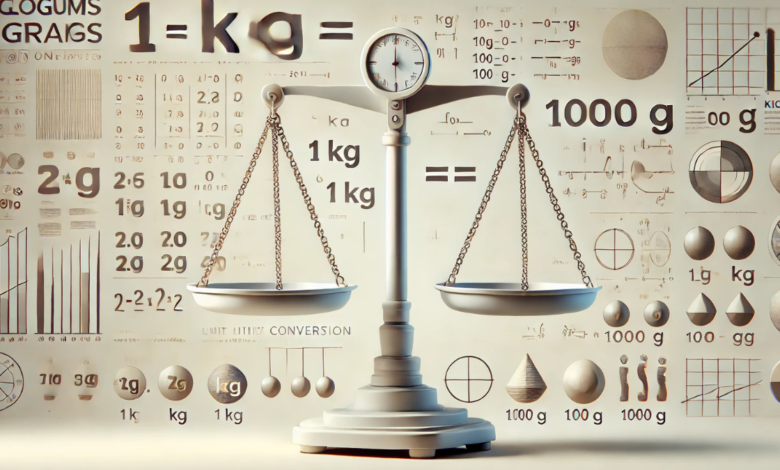Converting Kg to G: A Comprehensive Guide

Introduction
Understanding how to convert Kg to G is essential in many aspects of daily life and professional fields. This guide provides an in-depth look at these fundamental units of mass, the importance of precise conversions, and practical applications in various scenarios.The accuracy of weight measurements can be crucial in many situations, from cooking to science. Mass units like kilograms and grams are used globally, and understanding how to convert between these units is a valuable skill. This article explores the relationship between Kg to G, provides a clear conversion formula, and illustrates its application with practical examples.
Understanding the Basics
What is a Kilogram?
The Kg to G, symbolized as ‘kg’, is the base unit of mass in the International System of Units (SI) and is widely used worldwide in science, industry, and everyday life. Initially defined in 1795 as the mass of one litre of water, the definition of a kilogram has evolved. Since 2019, it has been described by the physical constants of nature, specifically through the Planck constant, ensuring its stability and universality across global measurements.
Kg to G are crucial in fields that require large quantities, such as engineering and commerce, where heavy materials and products are commonly measured. The usage of Kg to G reflects the practicality of measuring heavier items efficiently, promoting consistency and accuracy in trade and scientific research.
What is a Gram?
A gram, denoted as ‘g’, is a smaller unit of mass in the metric system, defined as one-thousandth of a Kg to G. Its origin dates back to the French Revolution when it was part of the metrication movement to standardize measurements. In everyday use, grams are preferred for smaller items, such as ingredients in cooking or chemicals in a laboratory, where high precision is necessary.
The relationship between Kg to G is fundamental in metric conversions, ensuring that measurements are scalable and adaptable across different contexts. Grams are critical in ensuring precision and efficiency in the pharmaceutical and culinary arts industries.
How to Convert Kilograms to Grams

The Conversion Formula
Converting kilograms to grams is straightforward: 1 kilogram equals 1000 grams. This conversion is crucial for tasks requiring precise weight measurements, such as pharmaceutical dosing or material science. To convert, multiply the kilograms by 1000 to get the equivalent number of grams.
For example, if a package weighs 3.5 kilograms, converting this to grams would involve multiplying 3.5 by 1000, resulting in 3500 grams. This simple multiplication can ensure accuracy in shipping, cooking, and science, where precise measurements are paramount.
Practical Examples
Everyday life often requires the conversion of kilograms to grams. In the kitchen, recipes might list ingredients in kilograms, but many kitchen scales display measurements in grams. Converting these measurements ensures accuracy in ingredient proportions, which is critical for the success of a recipe.
In another instance, fitness enthusiasts might track their weightlifting progress in kilograms, but equipment may only display in grams. Understanding how to convert these measurements allows individuals to follow their fitness regimes and monitor progress effectively and accurately.
Tools and Resources for Conversion
Digital Tools
In the digital age, numerous apps and online calculators can assist with converting kilograms to grams. These tools are handy when dealing with large numbers or complex calculations. By simply entering the number of kilograms, these tools provide an instant conversion to grams, eliminating potential errors in manual calculations.
Printable Conversion Charts
Printable conversion charts can be invaluable and used for those who prefer offline tools. Placing a laminated conversion chart in your kitchen, workshop, or laboratory can provide a quick reference, ensuring that conversions can be made quickly and accurately without digital devices. These charts aid in education and enhance efficiency in environments where time and accuracy are critical.
Conclusion
Understanding and applying the conversion of kilograms to grams is more than an academic exercise—it is a practical skill with numerous applications in daily life and professional environments. By using the tools and methods described, anyone can achieve accuracy in measurements, ensuring success in cooking, science, and any other field where precise mass measurements are necessary.
FAQs
Q: Why is it essential to convert kilograms to grams?
A: Converting kilograms to grams allows for precise measurements in various settings, ensuring the accuracy needed in recipes, scientific experiments, and commerce.
Q: What is the easiest way to remember the kilogram conversion to grams?
A: Remember that 1 kilogram equals 1000 grams. Multiplying by 1000 is a straightforward method that can be quickly applied.
Q: Are there common mistakes to avoid when converting kilograms to grams?
A: The most common mistake is forgetting to multiply by 1000, which can result in significant measurement errors, especially in sensitive applications like medication dosing.
Q: How can knowing this conversion benefit students in their studies?
A: Understanding unit conversion is crucial in chemistry and physics, where precise measurements affect experimental outcomes.
Q: Where can I find online tools to help with conversions?
A: Many websites and mobile apps offer free conversion tools; search for “unit converter” in your app store or online.
You May Also Read: https://ventsbuz.com/globetopper-revenue/





